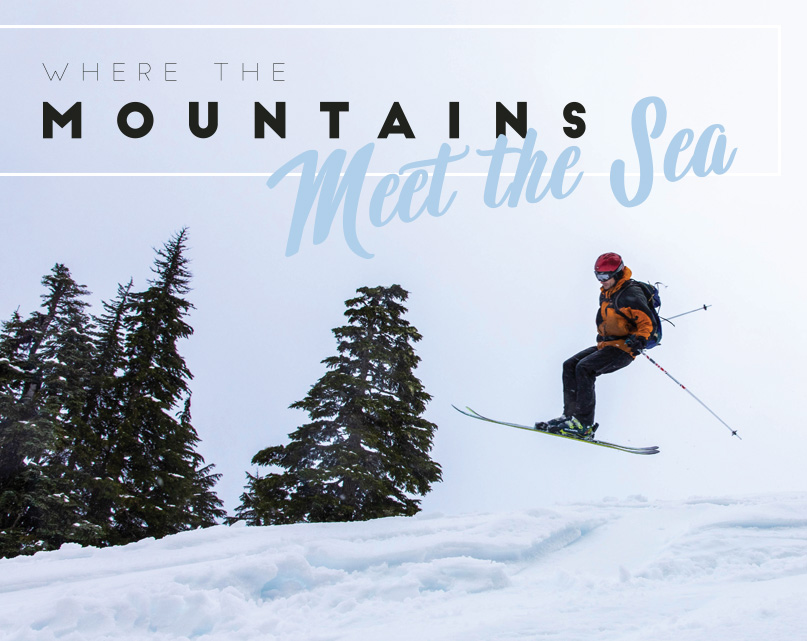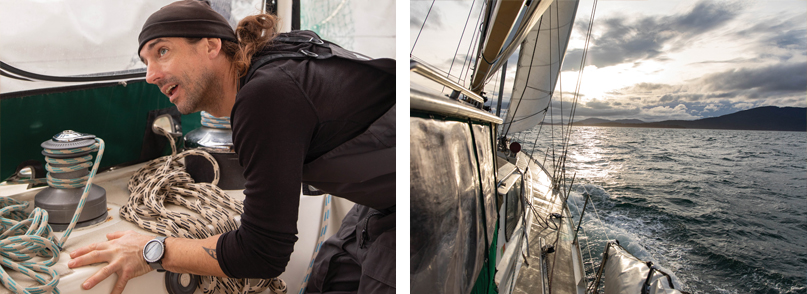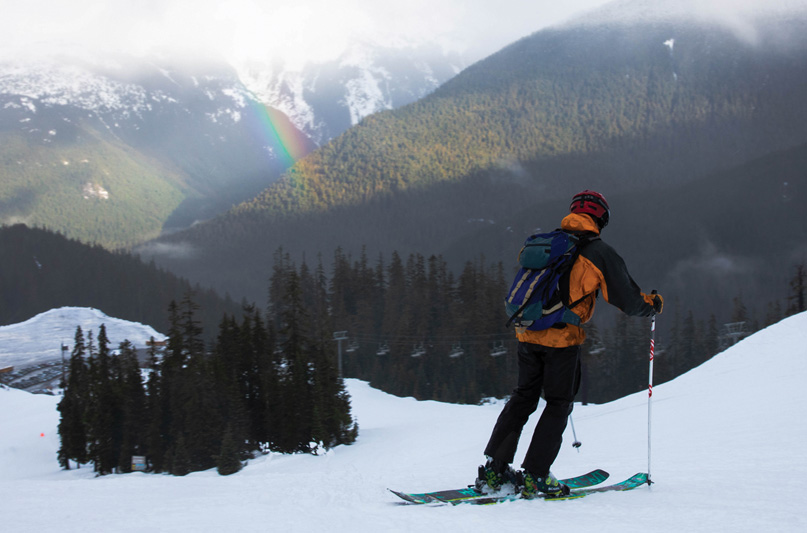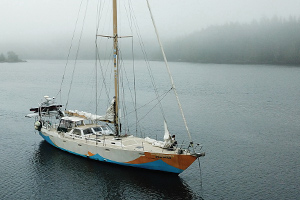
 That means one can carve up the slopes in the a.m. and sail off into the sunset in the p.m. This is old news to a select few lucky Pacific Northwesterners, but what I’ve found through my research and beer-riddled conversations is a same-day ski to sail adventure is one that has eluded many who live in or visit this region. If nothing else, it’s an epic Pacific Northwest bucket list item and one that I was eager to cross off. While I am a snowboarder and sailor, I’m no expert at either, so I hit up the man that lives and breaths West Coast adventure, Karl Kruger, to join me on my first Pacific Northwest ski-to-sail excursion from Mt. Baker to the Bellingham Bay.
That means one can carve up the slopes in the a.m. and sail off into the sunset in the p.m. This is old news to a select few lucky Pacific Northwesterners, but what I’ve found through my research and beer-riddled conversations is a same-day ski to sail adventure is one that has eluded many who live in or visit this region. If nothing else, it’s an epic Pacific Northwest bucket list item and one that I was eager to cross off. While I am a snowboarder and sailor, I’m no expert at either, so I hit up the man that lives and breaths West Coast adventure, Karl Kruger, to join me on my first Pacific Northwest ski-to-sail excursion from Mt. Baker to the Bellingham Bay.
You might recognize Kruger from his legendary stand-up paddleboard performance in the 766-mile Race to Alaska (R2AK) from Port Townsend to Ketchikan, Alaska, in 2017. “That race changed me,” he explains. It took him 15 days to navigate the San Juan Islands, the Gulf Islands, and Canada’s wild coast before crossing the Ketchikan finish line. When he’s not sailboat racing, surfing in the Gulf Islands, or skiing the Cascades, Kruger is managing his Orcas Island carpentry business and running his charter company, Kruger Escapes. He offers Ski & Sail and Ski & Surf charters, among others, making him the perfect adventure buddy for today’s excursion.
We chat lightly about the Pacific Northwest’s ski-to-sea phenomenon we’re so lucky to experience. “I originally moved to Bellingham for this,” explains Kruger, as he takes a bite of the lox and cream cheese bagel he picked up from Graham’s Store in Glacier on Mt. Baker Highway. There’s something special about experiencing the adventure of both the mountains and the sea in the same day that drew him to this region and has kept him around ever since.
Kruger always knew he wanted to own his own outdoor adventure company, but he wasn’t sure of its niche until he cruised north to Alaska aboard the 36-foot sailboat S/V Adios a little over 10 years ago. As they cruised along the Knight Inlet where heli-skiing is a popular activity and the mountains extend down to the water’s edge, it hit him: There surely must be others out there who are as stoked as he is about skiing, sailing, and surfing culture. Up north, there are endless unexplored outlets—Admiralty Island in Alaska being one of his favorites—and thus, Kruger Escapes was born.

Up north you can cruise up on your boat, hop off, hike up, and ski some fresh lines, ending at the water’s edge because the freezing point stretches from the top of the peaks to the lapping saltwater waves below. What more could you want? As he explains, I can see excitement exuding from every inch of his body and an eagerness to go after it. All he wants is to share that passion and explore these remote places with those who share his interests.
Windshield wipers work frantically to wipe away the straight downpour that accompanies our last leg to Mt. Baker Ski Area’s parking lot. We cross our fingers for a temperature drop upon our arrival, but to no avail. Oh, well, it’s all part of the adventure, right? We throw on our gear, carefully avoiding a wet sock fiasco in the slushy parking lot, and hurriedly catch the lift to escape the freezing rain at around 0900 hours. The good news? We have the entire mountain to ourselves.
Kruger hadn’t always been the skiing, sailing, and surfing powerhouse we know today. He was born into a family of climbers in upstate New York, where he once dreamed of becoming a professional. But reality hit hard when his climbing buddy, Steve Mascioli, was tragically killed on Mt. Hunter in Denali Park and Preserve in Alaska after a massive snow block broke loose.
On the chairlift, Kruger explains, “Finding a climbing buddy is like finding a wife.” He ponders that sentence for a moment before continuing, “maybe even harder than finding a wife.” Kruger, visibly shaken from that heartbreaking time in his life, said he found himself setting down his spikes and exploring other adventurous outlets shortly after. “I didn’t choose climbing,” he tells me, “but I did choose skiing, surfing, and sailing,” and he built Kruger Escapes on these interests.
We shred run after run and spend chairlift after chairlift chatting about his 10 years patrolling Baker as a volunteer. He points out some of his favorite drops and tells stories of his daughter Dagny’s first time on the hill, bundled up beneath his coat as he slalomed down the mountain. Before we know it, our morning is over and it’s time to head back down to sea level for our afternoon on the water.
A short hour and a half later and we’re greeted by Squalicum Harbor liveaboard, sailor, and friend of Karl’s, Rick Laursen, prepping Ocean Watch for our afternoon cruise. Sail cover and ties already removed, staysail awaiting orders, and the pressure of an oncoming front have us off the dock within 15 minutes of our arrival.
The 64-foot steel research vessel Ocean Watch was up for sale after its first 13-month expedition as a research vessel around the Americas and in need of a new captain. Karl was eyeing her for his own adventures when Mark Schrader, principal, founder, and captain popped the captain question. “It didn’t take much thought,” Karl tells me. “I immediately said yes.” As of May 2018, Kruger Escapes LLC is the new owner and captain of Ocean Watch and Karl plans to set sail for a two-year Around the Americas Expedition in June, made possible by Amazon Web Services, Google, MBARI, and Fable Vision, along with a few others.
Around the Americas is a 28,000-mile circumnavigation sail around North and South America with the purpose to inspire, educate, and engage with individuals about protecting our oceans. Scientists on board will host educational activities at each port and conduct research along the voyage. Karl will accept charter requests at various legs of his journey.
Sails hoisted and course set, Laursen breaks out the Oly’s (beer) and Kruger hands out our sandwiches as we talk story, relax, and enjoy the gusty Pacific Northwest day on Bellingham Bay. The plan is to round the tip of Eliza Island before heading back to the dock.

Sailing with Karl is effortless; he’s a pro and there’s no doubt about it. He floats over the deck with ease, clamping, tying, checking and double checking, and monitoring the wind, depth, speed, and every other little detail like it’s second nature. We chat, tack, cruise, jibe, gossip, and throw around jokes from the comfort of the heated cockpit.
For Kruger, 2018 has been a year chock full of risks. Acquiring Ocean Watch just scratches the surface of his year in review. The meaning of family is morphing into something vastly different from what he once imagined; he and Jess have very different ideas for the future, and in result, they’re navigating a separation.
But even with 2018’s challenges and the ones that have yet to come, he remains positive – a little unsure about what his future has in store for him, but positive, nonetheless. Something he said stuck with me from our earlier drive: “What’s the worst that could happen? You fail?” Big deal, he states. And worst case, he fails, and goes back to “car life” (the real life “van life” if you will), and it’s nothing he hasn’t done before. Kruger sings along to the song filling the cockpit: “It’s Too Late to Turn Back Now.”
“This is my 2019 theme song,” he says with a laugh.
You could classify Ocean Watch’s cabin as a small house; no crouching required. Once through the companionway, you’re greeted by L-shaped seating around a rectangular table flanked by adventure books and magazines. The full galley sits starboard at the bottom of the companionway and behind that is Kruger’s “bach pad.” The captain’s quarters features two bunks, one for Kruger and another for Dagny, his 12-year-old daughter who frequents Ocean Watch, although her favorite place is high in the spars, surprising visitors as they climb aboard. The work bench and nav station are port.
Amidships is another series of bunks to port and the roomy head to starboard. The V-berth features four more bunks – the scientists’ quarters. Throughout the sail, Kruger hops below and above deck as needed, but spends most of his time at the helm, occasionally skipping up to the second helm while raising and lowering the main.
We scoot past a submerged rock and round the tip of Eliza Island as the sun peeks through the clouds, producing a bright orange brushstroke across the horizon. Kruger is across the cockpit from me with a smile stretched ear to ear. “This is what I want to do for the rest of my life,” he says, reflecting on our ski-to-sail day and thinking about his waterborne future. I can’t blame him. We’re cruising along with 15-25 mph winds; we’re surrounded by islands, the sun warms my face, and I think I know how he feels.
What’s next for Karl Kruger? Well, the Around the America’s journey of course, but first thing’s first; he’s due for another paddle. “When you get to the end of an experience like that, why would you stop there?” he explains as he reminisces about his R2AK paddle in the movie trailer for his next great excursion.
“I can’t stop… Paddling through the Northwest Passage just seems like the next logical progression,” he continues. The Northwest Passage is a sea route that connects the Pacific to the Atlantic above the arctic circle; a route that was unsuccessfully attempted by early explorers for years due to its frozen waters until Norwegian explorer Roald Amundsen successfully completed it in 1906. As the Earth continues to warm, the ice continues to melt, which has made it possible for more and more vessels to navigate these icy waters, and additionally, Karl to take a stab at stand up paddling this harsh stretch of sea.
“Alright, Eva, this is you!” says Laursen as we’re about to jibe. I haul in the sheet, Kruger’s at the helm, and Laursen adjusts the main for our return trip. The wind significantly lessens, so we drop the staysail, start the engine, and motorsail back to arrive at the dock before dark.
“There’s just one last thing that’s still uncertain about her,” Kruger says with a smile, “her fuel capacity.” I’m not worried. Worst-case scenario, we raise the sails for the remainder of our journey and drop anchor upon our arrival, as she’s way too heavy for the average mooring buoy.

There’s a never-ending list of uncertainties that comes with a newly acquired boat, Kruger tells me. Each vessel is different and comes with its own quirks. Since May, he’s sailed her enough to work out almost all the intricacies of the 64-foot beast, except this one. The vessel houses two 100-gallon tanks and four 50-gallon tanks, plus another 50-gallon heater tank, and according to Kruger, we should be fine if the dial is accurate.
We make it back to Squalicum Harbor post-sunset, safe and sound, but a little darker than he’d hoped. “I’ve only ever had to use my thrusters three times, and this isn’t going to be one of them,” the challenge evident in his voice as we approach the dock. To no surprise, Kruger effortlessly tucks her in between a catamaran and another monohull for the night.
Now that I can speak from experience, one day hardly does justice to a slope-to-sea Pacific Northwest adventure. While Baker to Bellingham is an epic close-to-civilization option, the whole coast past the San Juan Islands into the Gulf Islands and up north along the British Columbia coast and to Alaska is primed for this kind of experience. Not only will there be fresh powder and beautiful breaks, but you’ll often have the entire area to yourself; ski, sail, surf, sleep, repeat. From ski to sea or mountains to sound, may there always be red skies at night and a layer of fresh pow.



